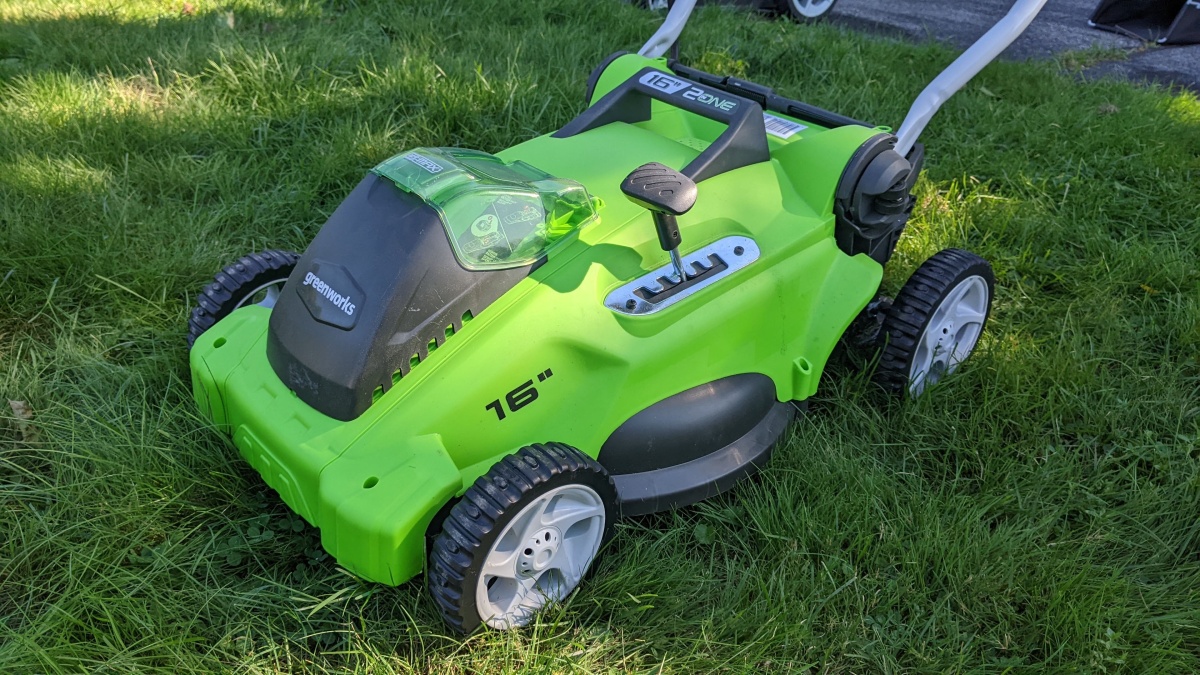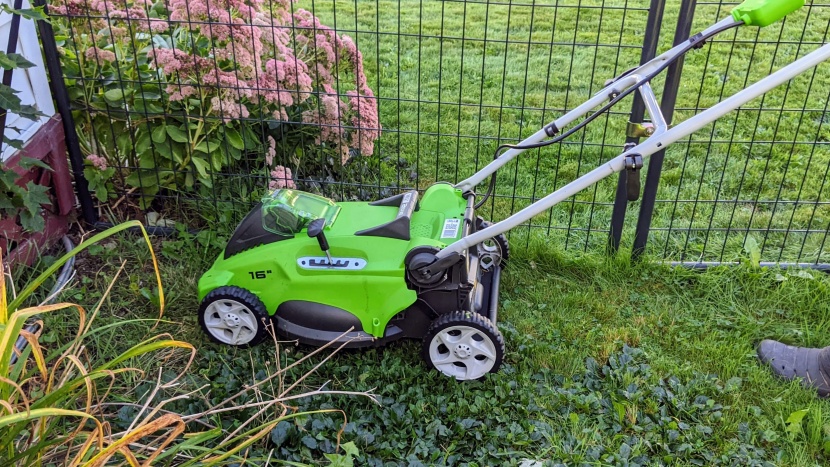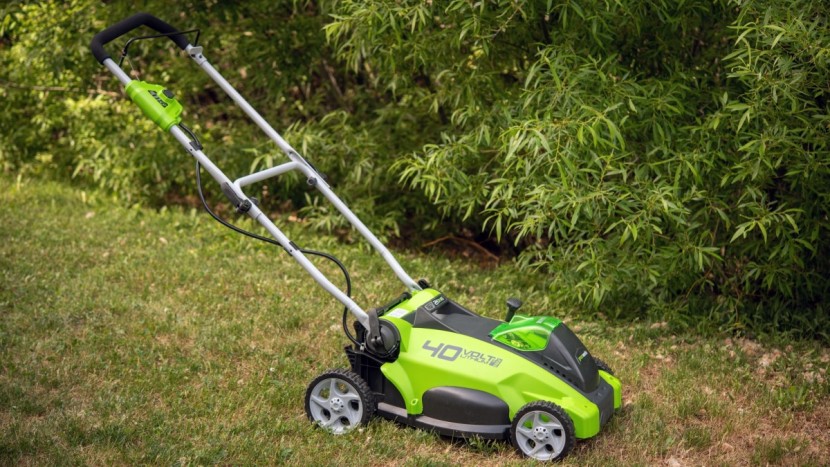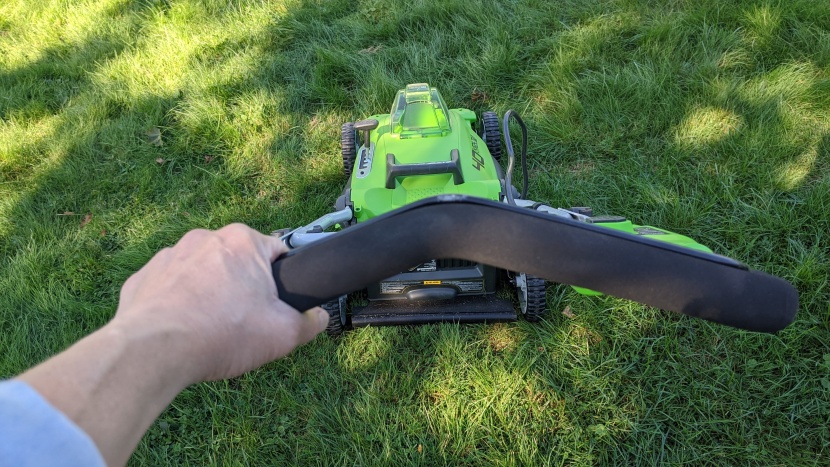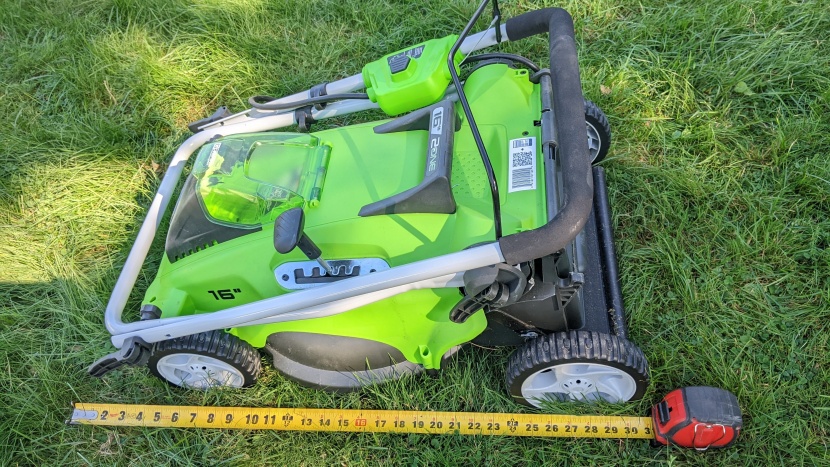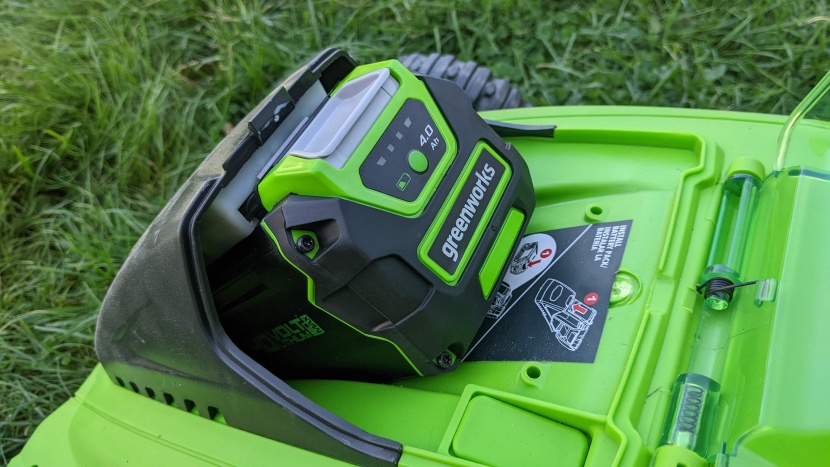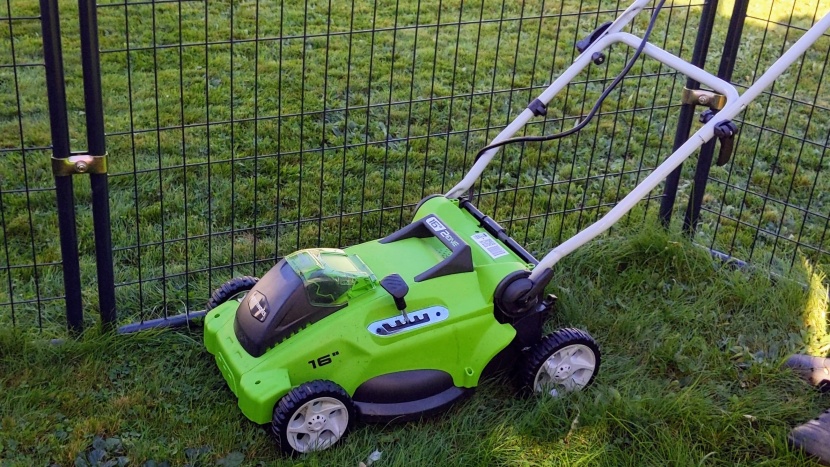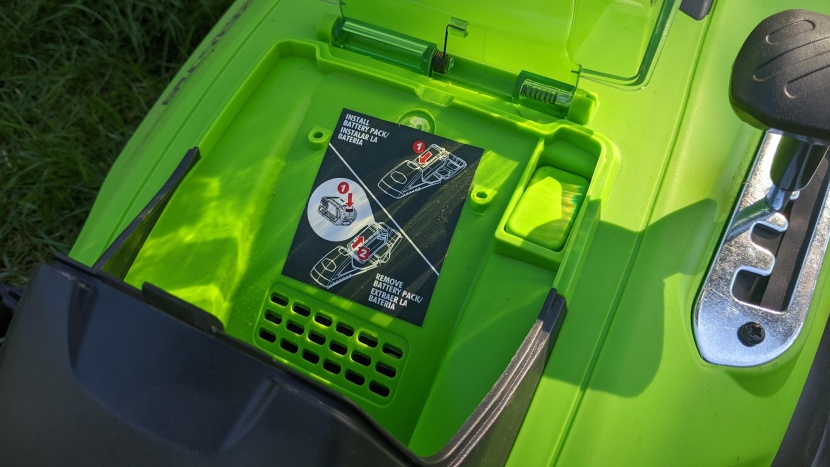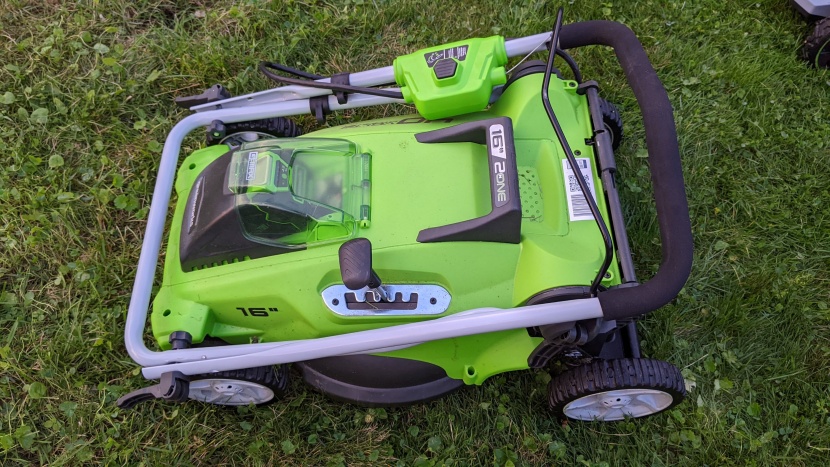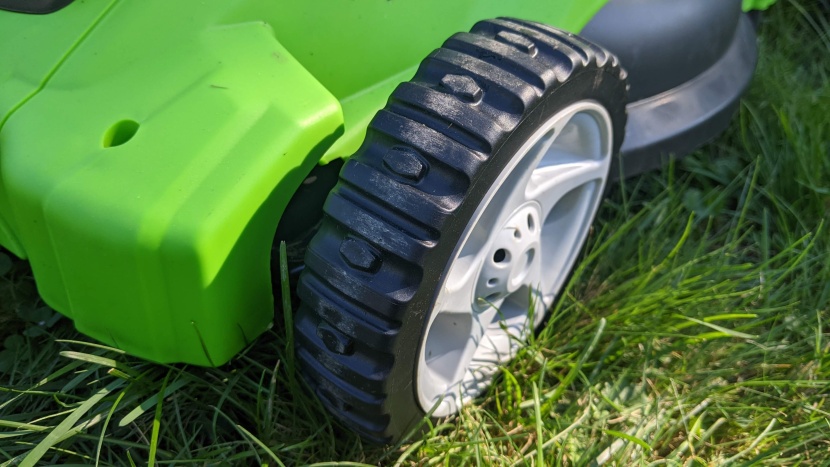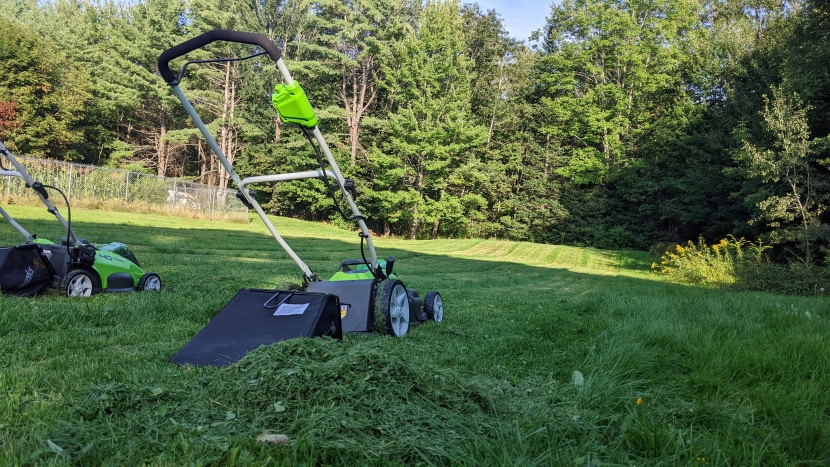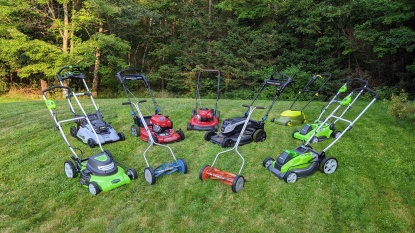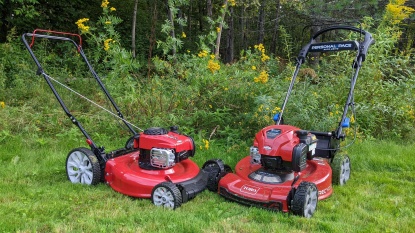Our Verdict
Compare to Similar Products
 This Product Greenworks 25322 | |||||
|---|---|---|---|---|---|
| Awards | Best Battery Model For Your Money | An Affordable Fuel Version | A Trusty & Reliable Classic | ||
| Price | $300 List $299.99 at Amazon | $369 List | Check Price at Amazon | $150 List $82.99 at Amazon | $150 List $83.99 at Amazon |
Overall Score  |
|||||
| Star Rating | |||||
| Bottom Line | An affordable, electric mower that's perfect for small yards | Sturdily built with a trusted engine, this high-performing motor should last | This great mower can't overcome the fact that mowing with a cord is annoying | A solid manual option for those with small yards and simple tastes | This easy-to-use manual reel mower was dull and required some adjustment |
| Rating Categories | Greenworks 25322 | Troy-Bilt TB110 | Greenworks 25022 | American Lawn Mower... | Great States 204-14 |
| Mowing (35%) | |||||
| Power Performance (25%) | |||||
| Handling (20%) | |||||
| Ease of Use (15%) | |||||
| Noise (5%) | |||||
| Specifications | Greenworks 25322 | Troy-Bilt TB110 | Greenworks 25022 | American Lawn Mower... | Great States 204-14 |
| Power Source | 40V, 4Ah Lithium Battery | Gas | 12 Amp Electric - Cord | Reel | Reel |
| Cutting Deck Width | 13 3/4" | 21" | 16" | 14" | 14" |
| Self-Propelled | No | No | No | No | No |
| Measured Cutting Gap | 1" | 1/4" | 1/4" | N/A | N/A |
| Measured Recharge/Refuel Time | 65 min | 2 min | n/a | n/a | n/a |
| Measured Decibel Reading | 72 dBa | 79 dBa | 76 dBa | 66 dBa | 66 dBa |
| Watt Hours | 160 | N/A | N/A | N/A | N/A |
Our Analysis and Test Results
The Greenworks 25322 has a relatively long runtime, a wide range of cutting heights, and is relatively quiet. Unlike our favorite options, though, it's not self-propelled. And, since it's not the most powerful mower we've gotten our hands on, it can be tiring to push. The narrow deck is also slower to cover ground, leaving you working longer and harder than you would with the top-scoring models.
Mowing
This 16-inch deck mower is less powerful than the top-performing battery options, often forcing us to retrace our steps for a consistent cut. The 15.5-inch blade is also one of the shortest in the test, meaning that you cover less of your yard with each pass. As a result, we only recommend this machine for quite a small yard, one you wouldn't mind walking over one and a half times to get a good trim.
That's especially true since you have to overlap your passes. If you trace the same wheel path walking up and down your yard, the mower leaves a mohawk of grass between. In thick grass taller than five inches, the engine tends to bog down, and you have to slow down to get a decent cut and keep the motor from shutting down.
The bottom line is that you're going to spend more time mowing with this machine than with larger, more powerful, and usually more expensive options. Luckily, it's light enough that the work doesn't feel too hard, especially on a smaller property. This mower works best if you're good at keeping your lawn under control by trimming it often.
Evenness and Terrain Management
The 25322 has a lightweight plastic deck, which is great when you're lugging it across a lawn, but not so awesome when it comes to getting an even cut across undulating terrain. Since the mower has so little heft and tends to bounce over small hills or dips instead of tracking them, it leaves patches of longer, unmowed grass behind on uneven sections of lawn. It doesn't mow perfectly over flat terrain either, often leaving taller tuffs or single flags of grass in its wake. It's especially inconsistent just before the battery dies.
Mulching
This mower leaves large clumps of grass behind more often than any other gas or battery option that we tested. We raked some of the piles, spreading them out to avoid damaging the lawn. They're also messy to walk through, leaving grass sticking to our shoes whenever we venture into the yard for days. The quality of the mower's mulching also suffers as the battery begins to die, leaving more piles of grass behind than ever. The mulching mode works best if you mow your lawn at least once a week, leaving you with fewer clippings overall. If you get behind often, this isn't your best bet.
Bagging
This mower is an impressive bagger, packing grass into the bag efficiently and holding an impressive amount. It's noticeably better than all but the top battery and gas-powered options. On the other hand, more cut grass escapes the bag than any other option in the test. As with any mower, when the bag is full, the engine loses power, prompting you to empty the grass, which is easy enough to do.
While mulching grass is better for your lawn, retaining nutrients and moisture, this mower is much better at bagging. We find that using mulching mode on a weekly basis and switching to bagging mode if your grass gets away from you is a good strategy for this mower.
Side Shoot
The 25322 we tested doesn't come with an attachment to convert it into a side shooting mode; mulching and bagging are your only options.
Cutting Deck Width and Height
As we've mentioned, the 16" deck and 15.5" blade don't cover ground very quickly. We like it best for compact spaces like inside a garden plot or a fenced-in dog kennel.
The blade hangs 0.25" above the deck bottom, which is pretty standard. And you can adjust the bottom of the deck to five height settings ranging from 0.5" to 3.25", giving you a 2.75". We used the middle, #3 setting, which sits 1.75" above the ground by the front tires, and 2" in the rear.
Power Performance
This mower uses a 40-volt lithium battery with four amp hours, which equals 160 watt-hours. When you compare it to the other battery-powered options we tested, it's a respectable mid-range option. Still, it's a far cry from the 400-odd watt hours from the most powerful options in the test.
Run Time
We tested this mower's runtime twice. During both tests, temperatures were in the low to mid-70s, and the grass was between five and seven inches high. During the first test, it ran for 35.5 minutes. During the second, it ran for 46 minutes, for an average of 40.8 minutes. We chalk the disparity up to running through denser patches of grass during the first test than the second.
In 30 minutes, this 15.5-inch blade will be able to cut about 0.19 acres of grass if you walk at a three-mile-per-hour pace. Since the average American lawn size is s about a quarter acre according to Home Advisor, you might just make it. Investing in a second battery would make sure you do.
Charge Time
This mower's battery takes an average of 66 minutes to charge. If your yard is small enough to finish on one charge, this number isn't that important. If you have a larger lawn, it means you'll have to wait over an hour anytime you run out of juice.
If you invest in a second battery, you could finish even a slightly above-average yard in one fell swoop. For large yards, however, you will need to take a 20-minute break between charging the first battery after you run the second one down. They aren't cheap, though.
Handling
The 25322 earns a middle-of-the-road handling score. It doesn't have the design features, like larger wheels in the back than the front, or the bells and whistles, like self-propulsion, to be a top contender in this metric. But it is small and light enough that it never feels challenging to move around.
Pushing
This mower has a comfortably cushioned handle at a height that works well for most adults. You can also change the handle angle fairly easily to alternate between using your arms primarily, or your core.
Though it's lightweight, this mower can still force you to power up a hill or through thick patches of grass, where it slows down noticeably. That makes it difficult for this mower to compete with self-powered options.
Turning
With a compact wheelbase, the 25322 has a tight turning radius and is fairly easy to navigate around obstacles. The front and rear wheels are similar in size, though, and we find that the mowers that turn on a dime have much larger wheels in the back than the front.
Starting/Stopping
The bail bar on this mower is intuitive and easy to hold in place. Once you let it go, the blade stops promptly, though not immediately, taking about a second to slow. To fire up the engine, simply press and hold the start button, then pull and hold the bail bar back.
Ease of Use
This simple lawn mower is one of the easiest in the test to put together, set up, and start. The short and simple directions are easy to follow, though they didn't give much information about cutting height options. While some battery-powered options shipped the battery separately, this one arrived in the package with the 25322. The bagging accessory arrived assembled as well. Like all the mowers we tested, this one arrived set up for mulching mode. Folding it for storage isn't as smooth as other models, though.
Changing Mowing Heights and Modes
You can change the deck height of the mower to accommodate various grass heights with one hand. Simply shift the single handle to one of five settings, and it adjusts all four wheels at once. To switch between mulching and bagging modes, you just need to remove a plug from the rear of the deck and add a bag. Reversing the process is just as simple.
Placing and Reading the Battery
Charging, placing, and removing the battery is easy and intuitive for all of the mowers we tested. This one is no different. It isn't easy to read the battery while you're mowing, however, and we didn't notice any audible or visible indication of a low battery. The motor simply slowed down, losing power and cutting less effectively, before dying altogether.
Maintenance
Battery mowers are relatively new on the market, meaning we have less information to assess their long-term maintenance needs and durability. We don't anticipate any immediate issues with this mower, but our experience repairing small battery-powered engines is limited.
What we do know is that there are very few maintenance tasks while it's working well. Simply remove the battery for storage. We also know that the battery will die eventually, and you'll need to buy a new one, which is expensive, and find the most responsible way to dispose of the old one.
Adjusting and Folding
Adjusting the handle on this mower can be a bit of a hassle. To loosen the lower handle, you need to pop it out of its groove by pressing it either inward or outward, depending on the model. This process can be tricky, and it's easy to accidentally catch and pinch the cord in the process, adding to our frustration.
The upper handle, while easier to fold, folds in the opposite direction we expected it to. These quirks can make setup and storage more cumbersome than they should be.
Noise
We measured how loud the 25322 is at head height when you're pushing the mower. It registered at 71.9 decibels or one of the quietest options in the test. Since the World Health Organization suggests keeping noise levels below 80 decibels, this is an ear-friendly mower.
Should You Buy the Greenworks 25322?
This compact battery-powered mower is one of the most affordable options in the test, making it a good option for those with small yards and tight corners. It's best for folks who mow their lawns often since it doesn't deal well with longer grass.
What Other Lawn Mowers Should You Consider?
If you have a small yard and are good at cutting it frequently, the American Lawn Mower 1204-14 is a less expensive option. A reel-style mower is purely mechanical and requires no gas or electric power to work. That means you have to push it a bit hard to work through thick patches, though. It will save you money in the short and long term but does require more strength to use. The larger deck will save you some mowing time, but we wouldn't pay much more for it. The corded Greenworks 25022 is more powerful and a more consistent cutter, but the cord is so annoying that we'd rather mow the entire yard twice.


